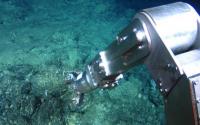Revision of Deep seabed mining is technologically feasible from Tue, 08/19/2014 - 23:22
The technology for deep-sea mining is already widely available, consisting of mining support platform or vessel; a launch and recovery system; a crawler with a mining head, centrifugal pump and vertical transport system; and electrical, control, instrumentation and visualization systems. Companies such as Lockheed Martin, Soil Machine Dynamics, IHC Mining and Bauer or Nautilus Minerals are developing vehicles for deep-sea mining, pledging they are in the position to readily develop techniques to operate down to 5,000 metre depth.
Quicktabs: Arguments
One reason massive-sulphide formations beguile miners is that the metals they contain—notably copper, gold, zinc and silver—are highly concentrated. Another is that they are often big, 200 metres wide and long, tens of metres thick, and may contain several million tonnes of ore. All lie on the surface of the seabed, and many are only 1-2km below water level. At that depth technology developed for the offshore oil industry can nowadays be employed for mining. In particular, the deep-water pumps and suction pipes developed to bring subsea oil up to the surface can be used in the riser pipes needed to bring minerals (mixed with water) up from a massive-sulphide mine. The oil industry has also developed remotely-operated vehicles to make trenches for seabed pipelines, which can be adapted for cutting ore, even though it may lie much deeper, at, say, 1.5km down. In general the technology in the machines needed to carry out deep-water mining is no longer exotic. Woods Hole Oceanographic Institution has a vehicle that can reach depths of 11km.
Indeed, at a summit on Deep-Sea Mining in London two months ago Mark Brown, Minister of Minerals and Natural Resources of the Cook Islands, announced that the Cook Islands is embracing deep-sea mining as a pathway to multiply the country’s gross domestic product by up to 100 fold, as they assessed that the Cook Islands' 2 million Km2 exclusive economic zone contains 10 billion tons of manganese nodules, which contain manganese, nickel, copper, cobalt and rare earth minerals used in electronics. Negotiations are under way between the Cook Islands and companies in the UK, China, Korea, Japan and Norway, towards granting the first tenders within a year.
These facts suggest that we may soon face and underwater gold rush, but in most citizen’s minds deep-sea mining is still something for sci-fic movies. Much to the contrary, the technology for deep-sea mining is not something of the future but it is largely existing. A deep-sea mining operation consists of a mining support platform or vessel; a launch and recovery system; a crawler with a mining head, centrifugal pump and vertical transport system; and electrical, control, instrumentation and visualization systems. Companies such as Lockheed Martin, Soil Machine Dynamics, IHC Mining and Bauer or Nautilus Minerals are developing vehicles for deep-sea mining, pledging they are in the position to readily develop techniques to operate down to 5,000 metre depth. Indeed, the submarine vehicles required are already in existence and their operations are described in compelling animations.

A quiet international rush is under way to stake out seabed claims to valuable minerals, concentrating on the central Pacific. Led by big businesses such as the US defence contractor, Lockheed Martin, it offers the dream of fortunes to poor island nations.
[ More ]